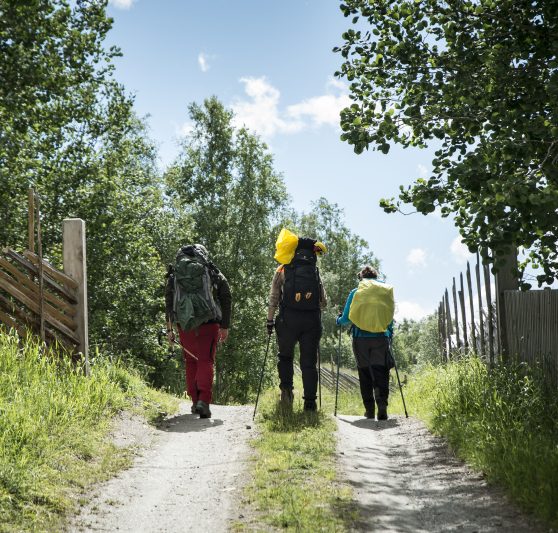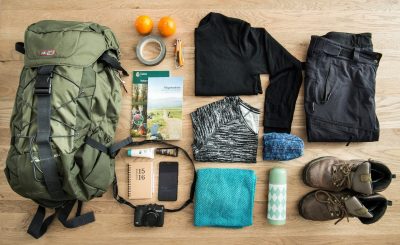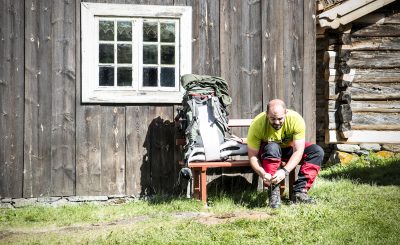Preparations and packing list
A prepared pilgrim is a happy pilgrim! Here are our tips on how to prepare before hiking the pilgrim paths in Norway.

Walk at the right time of the year
The main season for pilgrimage in Norway is between 1st June and 1st September. Routes that go over the mountains have a shorter season due to snow and snowmelt, while some other routes are accessible and have open accommodations also in the spring and autumn. Learn more in the pages about each of the 9 trails.
You can also check with the regional pilgrim center for the area you plan to walk in, they can tell you what time of year it is recommended to walk, and how the current conditions are.
It is also important to check the weather forecast along the way.
Read up
Although it is relativly safe to hike in Norwegian forests and mountains, you should have some knowledge and take some precautions before going on a long hike. Here you can read about safety on the Norwegian pilgrim trails - Including emergency numbers, rules regarding camping and campfires, and advice on how to act when you encounter grazing animals and wildlife.
The pilgrim paths go through villages, agricultural landscapes, valleys and forests. Some of the paths also pass through demanding mountain terrain. If you are going to cross mountains, it's important that you learn about the safety principles for travel in the Norwegian mountains. We strongly recommend that you familiarize yourself with the Norwegian Tourist Association's Mountain Code before embarking on your pilgrimage.
Get fit
On a pilgrimage you usually walk about twenty kilometres a day, several days in a row. A good advice is to go for long walks well in advance of the pilgrimage. Then you'll get familiar with the shoes you are going to wear and the weight of your backpack, and you get in better shape. Stretching out regularly is also important to increase mobility and prevent strain injuries.

Take your time
A pilgrimage can be demanding, especially if it lasts for several weeks. Time pressure is not a good feeling, so we recommend that you plan for a resting day per week. Then you'll have time to relax and recover. Plan your daily stages using the digital map in our planner:
Plan ahead
When you are on your pilgrimage, contact the accommodations a day or two in advance to book accommodation. If you have made a reservation but change your plans, it is important to cancel so that the host does not think you might have gotten lost.
Bring enough food
If you're not part of an organized pilgrimage, you should bring three meals with you in the backpack. The distances vary between grocery stores and it is better to be safe than sorry.
In many accommodations you are served breakfast and dinner, but this varies from place to place. Not all accommodations can be paid by credit card. It is therefore recommended to bring with you around 3000 NOK in smaller notes.
Wash your clothes when you have the chance
Some accommodations offer laundry, in other places you do it yourself. Bring detergent in portioned bags and a nylon cord for drying clothes. Crumpled newspaper can help draw moisture from wet boots.

Clothes
Your clothing should cover a temperature range from 0 to 30 °C, and you should take into account that it might rain. A rain poncho covers you and your backpack, but is impractical in wind. A breathable rain jacket with a thin mesh lining will keep you dry, but remember rain cover for the backpack. Rain pants that can be put on without removing shoes are practical. See our suggesed packing lists for sleeping indoors or outdoors on your pilgrimage.
Footwear
The pilgrim paths through Norway are mostly on footpaths, asphalt and dirt roads and do not require heavy footwear such as traditional mountain boots with rigid soles. But your hiking shoes or boots must be wide enough, not just long enough - you need to be able to spread your toes, and there must be room for your feet to swell a little.
The shoes must provide good support, have good flex in the forefoot so they do not tilt, and cushioning that facilitates walking on the road. Ankle high shoes are better in wet terrain. If you have boots without cushioning, the use of soles in cushioning material can be helpful. If possible you can alternate between shoes, boots and sandals.
Prevent foot blisters
Your shoes should be broken in before you start the hike. Good padding of the feet prevents rashes and moist problems. One or two pairs of thin wool socks is a proven piece of advice. If possible, wash your socks daily. Two thinner socks per foot dry faster than one thick.
Concider gaiters
Simple gaiters keep pebbles, debris and moisture out of the boots. In areas with a lot of asphalt, it is recommended to change to lighter footwear with good cushioning. Learn about what surface you'll be walking on before the hike so you are well prepared.

Backpack
Backpacks of 50-80 litres, with stiffened back, padded carrying belt, and chest strap are available in many variants. The backpack should have the right length for you so that the weight is evenly distributed between shoulders and hips. Simple bags without too many pockets and straps often weigh less. If you are able to pack less than 10 kg, it's less important to have a padded carrier belt. You can use packing bags to sort the contents.
Other equipment
It is recommended to bring a light sleeping bag of 0.5–1 kg with a zipper on the side, since some of the basic accommodations do not include bed linen or wool blankets. In some accommodations you will also need a sleeping mat. This may also come in handy if you want to take a rest outdoors along the way.
We recommend a walking stick - or two. The backpack may disturb your balance, and the rod provides extra support. In steep areas it acts as a relief on the knees and your back. You can make one yourself, or buy a telescopic one. With rubber knob on the tip, it will make less noice.
Have a look at our suggested packing lists:
Maps and guidebooks
Gudbrandsdalsleden
- Moelv to Fåvang. 1:50 000 Turkart Lillehammer 1:50.000 - Kart - Calazo.no
- Fåvang to Otta. 1:50 000 Turkart Ringebu & Venabygdsfjellet 1:50.000 - Calazo.no
- Otta to Hjerkinn. 1:50 000 https://www.calazo.no/no/kart/...
- Hjerkinn to Oppdal. 1:50 000 https://www.calazo.no/no/kart/...
- Hjerkinn-Oppdal 2. 1:50 000 https://www.kartbutikken.no/ca...
- Buvika-Trondheim/ Nidaroscathedral. 1:25 000 https://www.calazo.no/no/kart/...
St.Olavsleden.
- Hell/Ersgard to Nidarosdomen. 1:25 000 https://www.calazo.no/no/kart/...
Romboleden
- Skarvdörrsfjället to Selbustrand. 1:50 000 https://www.calazo.no/no/kart/...
- Selbustrand north to Trondheim/ Nidaroscathedral. 1:25 000 https://www.calazo.no/no/kart/...
Valldalsleden
- Valldal to Bjorli. 1:50 000 https://www.calazo.no/no/kart/...
Guidebooks
- Valldalsleden - From Valldal to Fokstugu and on to Trondheim. Walking guide for the pilgrims' way to Nidaros in Norway.
Written by Ria Warmerdam. Published by Op Vrije Voeten, Amsterdam.
- Olavsweg - Von Oslo über Mjøsasee und Dovrefjell nach Trondheim.
Written by Susanne und Walter Elsner, Bergverlag Rother (2023). You can get it at Rother publisher or Oslo Pilgrim Center.
Please note that we cannot guarantee updated information in guidebooks, these may be out of date. You can find updated information on the digital map at pilegrimsleden.no

